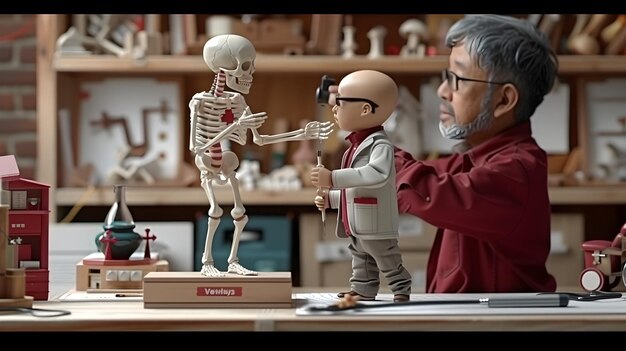Ever wonder what makes your heart beat or how you can move your arm? The fascinating world of human anatomy and physiology answers these questions by exploring how our bodies are structured and how they function. This guide delves into the essential components of anatomy and physiology, uncovering the marvels of the human body.
Basic Concepts in Human Anatomy
The Human Body Planes
Understanding the human body begins with its planes of reference. The three primary planes are:
- Sagittal Plane: Divides the body into left and right parts.
- Frontal (Coronal) Plane: Splits the body into anterior and posterior sections.
- Transverse Plane: Separates the body into superior and inferior portions.
These planes help in describing the locations of body parts and their movements.
Anatomical Terms of Movement
To describe how we move, specific terms are used:
- Flexion and Extension: Bending and straightening movements.
- Abduction and Adduction: Movement away from and towards the body’s midline.
- Rotation: Turning around an axis.
These terms provide clarity in describing body movements in both health and medical contexts.
Major Systems of the Human Body
The Skeletal System
The skeletal system forms the body’s framework, offering structure and protection. It includes:
- Structure and Function: The skeleton supports the body, protects internal organs, and facilitates movement.
- Major Bones: Key bones include the femur (thigh bone), tibia (shin bone), and the skull.
Understanding the skeletal system helps us appreciate its role in supporting and protecting the body.
The Muscular System
Muscles are responsible for movement, stability, and heat production. They are categorized into:
- Types of Muscles: Skeletal (voluntary movement), cardiac (heart function), and smooth (involuntary actions like digestion).
- Muscle Functions: Muscles work in pairs to create movement, stabilize joints, and maintain posture.
This system is essential for movement and maintaining bodily functions.
The Cardiovascular System
This system is responsible for transporting nutrients, gases, and waste products throughout the body:
- Heart Anatomy: The heart has four chambers – two atria and two ventricles.
- Blood Vessels: Include arteries, veins, and capillaries that carry blood to and from the heart.
Understanding the cardiovascular system is crucial for grasping how blood circulation impacts overall health.
The Respiratory System
The respiratory system facilitates gas exchange:
- Airway Anatomy: Includes the nasal passages, trachea, and bronchi.
- Breathing Process: Oxygen is inhaled, and carbon dioxide is exhaled through complex mechanisms involving the diaphragm and intercostal muscles.
Effective respiration is vital for delivering oxygen to the bloodstream and removing waste gases.
The Digestive System
The digestive system breaks down food to extract nutrients:
- Digestive Tract Overview: Starts from the mouth and ends at the anus.
- Key Digestive Organs: Include the stomach, intestines, and liver.
The digestive process ensures that our bodies receive essential nutrients and energy.
The Nervous System
The nervous system controls and coordinates body activities:
- Central Nervous System (CNS): Comprises the brain and spinal cord.
- Peripheral Nervous System (PNS): Connects the CNS to limbs and organs.
It plays a critical role in sensory perception, movement, and homeostasis.
The Endocrine System
The endocrine system regulates body processes through hormones:
- Major Glands: Include the pituitary, thyroid, and adrenal glands.
- Hormonal Regulation: Hormones are chemicals that regulate growth, metabolism, and mood.
This system is essential for long-term regulatory functions and maintaining balance in the body.
The Urinary System
This system removes waste products and regulates fluid balance:
- Kidney Function: Kidneys filter blood to produce urine.
- Urine Production and Excretion: Involves the kidneys, ureters, bladder, and urethra.
The urinary system helps in maintaining homeostasis and removing toxins.
The Reproductive System
The reproductive system is crucial for producing offspring:
- Male and Female Anatomy: Includes structures like testes and ovaries.
- Reproductive Processes: Involves hormone regulation and reproductive cycles.
Understanding this system is important for reproductive health and development.
Integration of Systems
All these systems work in concert to maintain overall health:
- How Systems Work Together: For example, the cardiovascular system delivers oxygen needed for cellular respiration, which supports muscular function.
- Homeostasis and Regulation: The body maintains a stable internal environment despite external changes through complex regulatory mechanisms.
Common Disorders and Diseases
Skeletal System Disorders
Disorders such as osteoporosis and arthritis affect bone strength and joint function.
Muscular System Disorders
Conditions like muscular dystrophy and strains impact muscle function and movement.
Cardiovascular Diseases
Heart disease, hypertension, and stroke are common cardiovascular disorders that affect blood flow and heart health.
Respiratory Disorders
Asthma, bronchitis, and chronic obstructive pulmonary disease (COPD) impact breathing and lung function.
Digestive System Issues
Gastroesophageal reflux disease (GERD), ulcers, and irritable bowel syndrome (IBS) affect digestion and nutrient absorption.
Conclusion
Understanding human anatomy and physiology provides insight into how our bodies function and how different systems interact to maintain health. It highlights the complexity and interdependence of bodily systems, underscoring the importance of a holistic approach to health and well-being.
FAQs
What is the difference between anatomy and physiology?
Anatomy studies the structure of body parts, while physiology focuses on their functions and processes.
How does the nervous system communicate with other systems?
The nervous system uses electrical signals to send messages to other systems, coordinating responses and maintaining homeostasis.
What are the major functions of the digestive system?
The digestive system breaks down food, absorbs nutrients, and eliminates waste.
How do the skeletal and muscular systems work together?
The skeletal system provides a framework for muscle attachment, and muscles contract to move bones, enabling movement.
What are some common disorders of the respiratory system?
Common disorders include asthma, bronchitis, and chronic obstructive pulmonary disease (COPD), which affect breathing and lung health.
